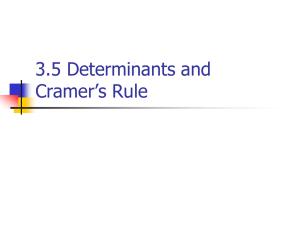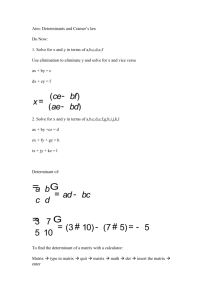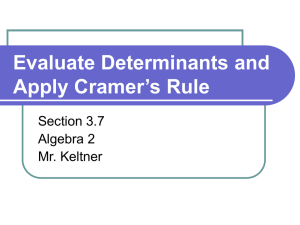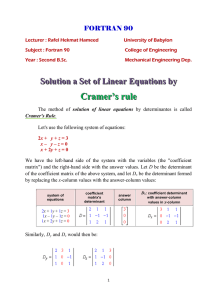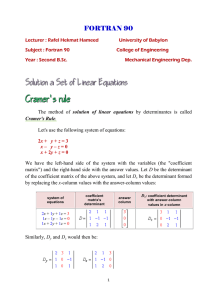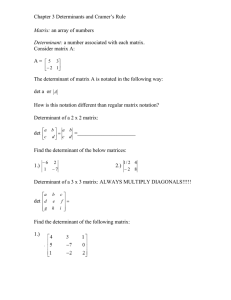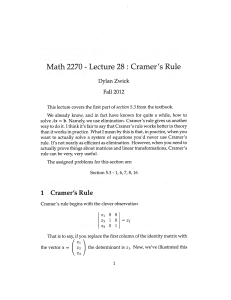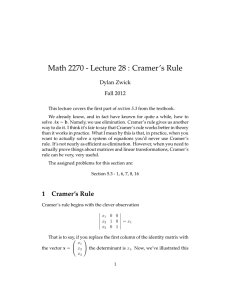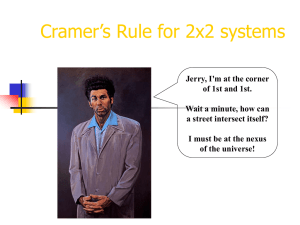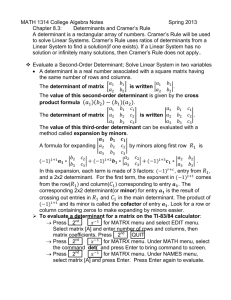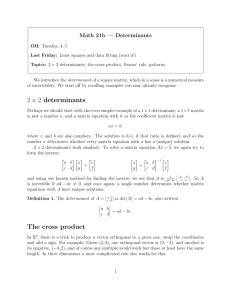4.3 Determinants & Cramer`s Rule
advertisement
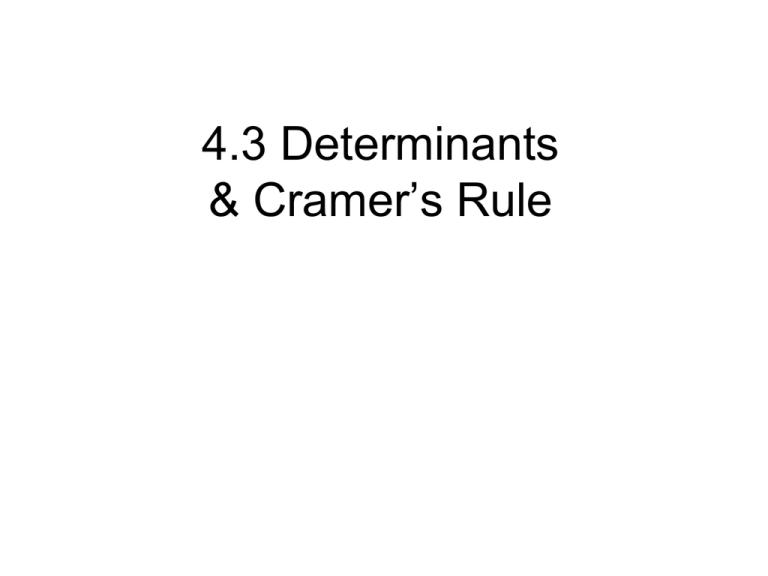
4.3 Determinants & Cramer’s Rule Objectives/Assignment Warm-Up Solve the system of equations: (2,1) What is the product of these matrices? 4 8 5 6 Associated with each square matrix is a real number called it’s determinant. We write The Determinant of matrix A as det A or |A| Here’s how to find the determinant of a square 2 x 2 matrix: Multiply Multiply 4 8 5 6 40 (2 nd ) 24 (1 ) Now subtract these two numbers. st 24 (1 ) st - 40 (2 nd ) = -16 -16 is the determinant of this matrix In General a det c b ac ad bc d bd Determinant of a 3 x 3 Matrix a det d g b e h c f i (gec +hfa +idb) a d g b e h c a b d e f i g h (aei+bfg +cdh) Now Subtract the 2nd set products from the 1st. (aei + bfg + cdh) - (gec + hfa + idb) Compute the Determinant of this 3 x 3 Matrix 2 1 3 det 2 0 1 1 2 4 (0 +4 +8) 2 1 3 2 -1 2 0 1 -2 0 1 2 4 1 2 (0+ -1 -12) Now Subtract the 2nd set products from the 1st. (-13) - (12) =-25 You can use a determinant to find the Area of a Triangle (a,b) The Area of a triangle with verticies (a,b), (c,d) and (e,f) is given by: (e,f) a b1 1 c d1 2 e f 1 (c,d) Where the plus or minus sign indicates that the appropriate sign should be chosen to give a positive value answer for the Area. You can use determinants to solve a system of equations. The method is called Cramer’ rule and named after the Swiss mathematician Gabriel Cramer (17041752). The method uses the coefficients of the linear system in a clever way. ax + by = e In general the solution to the system e b f d a b c d is (x,y) cx + dy = f x= where a b and =0 c d a e c f a b c d y= If we let A be the coefficient matrix of the linear system, notice this is just det A. Use Cramer’s Rule to solve this system: ax + by = e cx + dy = f 4x + 2y = 10 5x + 1y = 17 e b 10 2 f d 17 1 x= y= x= = a b 4 2 c d 5 1 a e 4 10 c f 5 17 a b 4 2 c d 5 1 y= (10)(1) –(17)(2) (4)(1) –(5)(2) = (4)(17) –(5)(10) = (4)(1) –(5)(2) = 10 - 34 4 - 10 68 - 50 4 - 10 = -24 =4 -6 = 18 = -3 -6 The system has a unique solution at (4,-3) Solve the following system of equations using Cramer’s Rule: ax + by = e cx + dy = f 6x + 4y = 10 3x + 2y = 5 e b 10 4 f d 5 2 x= x= (10)(2) –(5)(4) = a b 6 4 c d 3 2 (6)(2) –(3)(4) = 20 - 20 0 = 0 12 - 12 Since, the determinant from the denominator is zero, and division by zero is not defined: THIS SYSTEM DOES NOT HAVE A UNIQUE SOLUTION and Cramer’s Rule can’t be used. Cramer’ Rule can be use to solve a 3 x 3 system. ax by cz j a b c Let A be the coefficient matrix of dx ey fz k A d e f this linear system: gx hy iz l g h i If det A is not 0, then the system has exactly one solution. The solution is: j b c k e f l h i x det A a j c d k f g l i y det A a b j b e k c h l z det A
